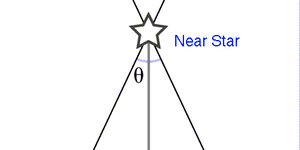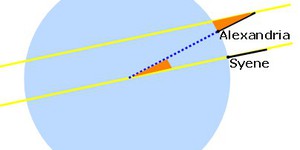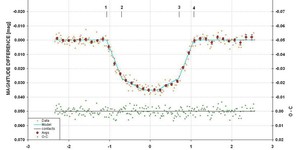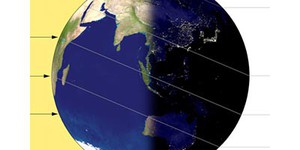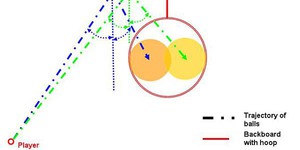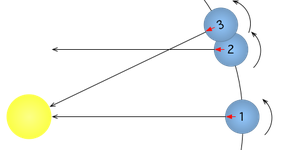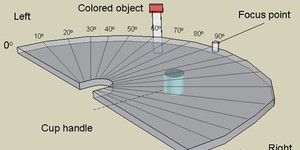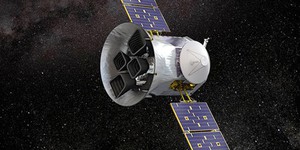Others Like “Similar Triangles: Using Parallax to Measure Distance” (top 20 results)
|
Do you enjoy going stargazing? In a good location on a clear night, you can see a huge number of stars twinkling in the night's sky. Have you ever wondered how far those stars are from us? Ancient astronomers actually discovered a way figure this out, measuring the distance from Earth to faraway stars. How did they do it without modern technologies? In this astronomy science project you will find out by exploring the link between the distance of an object and perspective (also known as…
Read more
How big a ruler would you need to measure the circumference of the Earth? Did you know that you can do it with a yardstick? (And you won't have to travel all the way around the world!)
Read more
In astronomy, a transit (or astronomical transit) is a phenomenon when a celestial body passes directly between a larger body and the observer. As viewed from a particular vantage point, the transiting body appears to move across the face of the larger body, covering a small portion of it.
The word "transit" refers to cases where the nearer object appears smaller than the more distant object. Cases where the nearer object appears larger and completely hides the more distant object are known as…
Read more
Many people are surprised to learn that the season's we experience—winter, spring, summer and fall—have nothing to do with the distance of Earth from the Sun. In this science fair project, you will investigate how the temperature on Earth actually depends on the tilt of Earth's axis of rotation.
Read more
The Kepler space telescope is a retired space telescope launched by NASA to discover Earth-size planets orbiting other stars. Named after astronomer Johannes Kepler, the spacecraft was launched on March 7, 2009, into an Earth-trailing heliocentric orbit. The principal investigator was William J. Borucki. After nine years of operation, the telescope's reaction control system fuel was depleted, and NASA announced its retirement on October 30, 2018.
Designed to survey a portion of Earth's region…
Read more
If you've ever played or watched basketball, you might already know that your chances of successfully banking a shot on the backboard are higher in certain positions on the basketball court, even when keeping the distance from the hoop the same. Ever wondered what would account for this? Do you think you could actually explain this using geometry? This science project will put your knowledge of geometry and algebra to good use. You will calculate and quantify how much more difficult it is to…
Read more
Do you wake up at the crack of dawn, or do you need an alarm clock to wake you up each morning? It may surprise you that the two are not always in synch. Nowadays, we use Standard Time to set our watches instead of Solar Time. Which method of timekeeping is the most accurate? Get ready to synchronize your watches!
Timekeeping is the science of how to keep time with precision and accuracy. People have been finding ways of measuring time for thousands of years, usually based on the movements…
Read more
Peripheral vision is important in our everyday lives because it allows us to gather a visual sense of our surroundings—without it, we would see the world through "tunnel vision." The survival of our ancient ancestors depended on their ability to use peripheral vision to find prey and to avoid predators. Almost everything we do—from riding a bike, to dribbling a basketball, to reading a book—depends on peripheral vision. In this human biology science fair project, you will test…
Read more
Globular clusters, compact groups of about a million stars that move around together in galaxies, are among the oldest objects found in the universe. Since they are found in most galaxies and since they've been around for so long, globular clusters have a lot to tell us about what the universe looks like now and how it got that way. Is our Milky Way Galaxy just like all the other galaxies out there? What are galaxies made of? What can we learn about the universe from looking at galaxies? …
Read more
The Transiting Exoplanet Survey Satellite (TESS) is a space telescope for NASA's Explorers program, designed to search for exoplanets using the transit method in an area 400 times larger than that covered by the Kepler mission. It was launched on April 18, 2018 atop a Falcon 9 rocket. During its two-year primary mission, it was expected to find more than 20,000 transiting exoplanets, compared to about 3,800 exoplanets known when it launched. The first light image from TESS was taken on August…
Read more
|
Explore Our Science Videos
Make A Tissue Paper Parachute - STEM Activity
Make an LED Night-Light
Is the Egg Raw or Cooked? STEM activity


